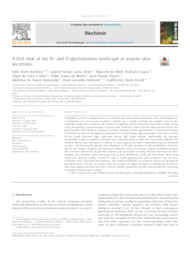A first look at the N- and O-glycosylation landscape in anuran skin secretions.
A first look at the N- and O-glycosylation landscape in anuran skin secretions.
Autoria: BARBOSA, E. A.; ALVES, G. S. C.; COURA, M. de M. A.; SILVA, H. de L. e; ROCHA, F. S. da; NUNES, J. B.; WATANABE, M. de S.; ANDRADE, A. C.; BRANDA, G. D.
Resumo: Amphibians secrete a complex array of molecules that shape their interactions with coinhabiting microorganisms and macroscopic predators. Glycans are a rapidly evolving and complex class of biomolecules implicated in intrinsic and extrinsic recognition events. Despite the numerous studies aiming at the biochemical characterization of anuran skin secretions, little is known about protein-linked oligosaccharides, their synthesis pathways, and their homing secreted glycoproteins. In the present report, LC-MS/MS was used to investigate the diversity of N- and O-linked oligosaccharides in the skin secretion of two South American frogs, Pithecopus azureus and Boana raniceps. Additionally, the enzymes responsible for glycan synthesis pathways were evaluated based on their skin tissue transcriptome. Our analyses allowed the annotation of various N- and O-glycan structures commonly found in vertebrate proteins. Paucimannosidic glycans were abundant in the skin secretion of both amphibians; however, hybrid and complex N-glycan structures were detected only in B. raniceps. A good correlation between the structures discovered in glycomic analyses and transcripts encoding enzymes necessary for their synthesis was obtained. Some transcripts such as those of MAN1A2, FUT8, and ST6GALNAC were found solely in B. raniceps. Finally, secreted N- and O- linked glycoproteins were predicted from the transcriptomic data, indicating that proteases and protease inhibitors are putative sources of the glycans described herein. Overall, our results show the presence of oligosaccharides in amphibians skin secretions and suggest that their diversity is species-specific, paving the way for novel perspectives involving amphibian evolution and ecology.
Ano de publicação: 2022
Tipo de publicação: Artigo de periódico
Unidade: Embrapa Café
Palavras-chave: Mass spectrometry, Oligosaccharides, Transcriptomics
Observações
1 - Por padrão são exibidas publicações dos últimos 20 anos. Para encontrar publicações mais antigas, configure o filtro ano de publicação, colocando o ano a partir do qual você deseja encontrar publicações. O filtro está na coluna da esquerda na busca acima.
2 - Para ler algumas publicações da Embrapa (apenas as que estão em formato ePub), é necessário ter, no celular ou computador, um desses softwares gratuitos. Sistemas Android: Google Play Livros; IOS: iBooks; Windows e Linux: software Calibre.
Acesse outras publicações
Acesse a Base de Dados da Pesquisa Agropecuária (BDPA) para consultar o acervo completo das bibliotecas da Embrapa.

